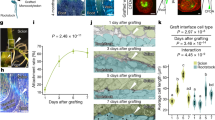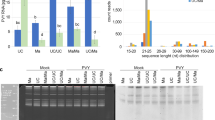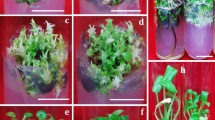Abstract
SEVERAL effects of gibberellic acid on plant growth and differentiation have been recognized1–4, but there have been no previous reports of any effect on tumorous genotypes in vivo. This communication reports the effect of gibberellic acid on a genetically controlled condition resembling a tumour and on vascular development in a tomato hybrid. The tumour condition appears on the hybrid plants carrying the Frosty spot (Frs) gene from Lycopersicon chilense on the background of L. esculentum variety ‘Tiny Tim’, and is transmitted as a dominant trait5. Tumours consisting of groups of undifferentiated parenchymatous cells develop along the veins of the leaves, after which the affected tissues become chlorotic and necrotic5,6. Plants with a tumour trait appear dwarfed and have poorly developed vascular tissue, which results in weak stems. The non-tumorous plants, however, are normal and show good vascular development. In the tumorous plants, differentiation of vascular tissue stops after three to six layers of secondary xylem have been formed (Fig. 1A). In contrast to this, the derivatives of cambium in the normal genotype are many and show relatively more lignification in the secondary xylem (Fig. 1B).
This is a preview of subscription content, access via your institution
Access options
Subscribe to this journal
Receive 51 print issues and online access
$199.00 per year
only $3.90 per issue
Buy this article
- Purchase on Springer Link
- Instant access to full article PDF
Prices may be subject to local taxes which are calculated during checkout
Similar content being viewed by others
References
Bradley, M. V., and Crane, J. C., Science, 126, 972 (1957).
Lang, A., 25th Symp. of the Soc. for Devlp. Biol., 251 (1966).
Waisel, Y., Noah, I., and Fahn, A., New Phytologist, 65, 319 (1966).
Digby, J., and Wareing, P., Ann. Bot. (N.S.), 30, 539 (1966).
Martin, F. W., Ann. Bot., 30, 701 (1966).
Doering, G. R., and Ahuja, M. R., Planta, 75, 85 (1967).
Sachs, R. M., Ann. Rev. Plant Physiol., 16, 73 (1965).
Paleg, L. G., Ann. Rev. Plant Physiol., 16, 291 (1965).
Clutter, M. E., Science, 132, 548 (1960).
Jacobs, W. P., Amer. J. Bot., 39, 301 (1952).
Wetmore, R. H., and Rier, J. P., Amer. J. Bot., 50, 418 (1963).
Author information
Authors and Affiliations
Rights and permissions
About this article
Cite this article
AHUJA, M., DOERING, G. Effect of Gibberellic Acid on Genetically Controlled Tumour Formation and Vascularization in Tomato. Nature 216, 800–801 (1967). https://doi.org/10.1038/216800a0
Received:
Issue Date:
DOI: https://doi.org/10.1038/216800a0
This article is cited by
-
The initiation of Xylem differentiation
The Botanical Review (1969)
Comments
By submitting a comment you agree to abide by our Terms and Community Guidelines. If you find something abusive or that does not comply with our terms or guidelines please flag it as inappropriate.



